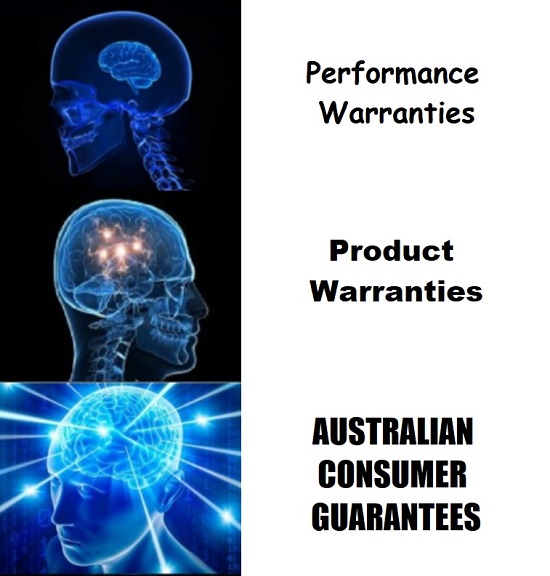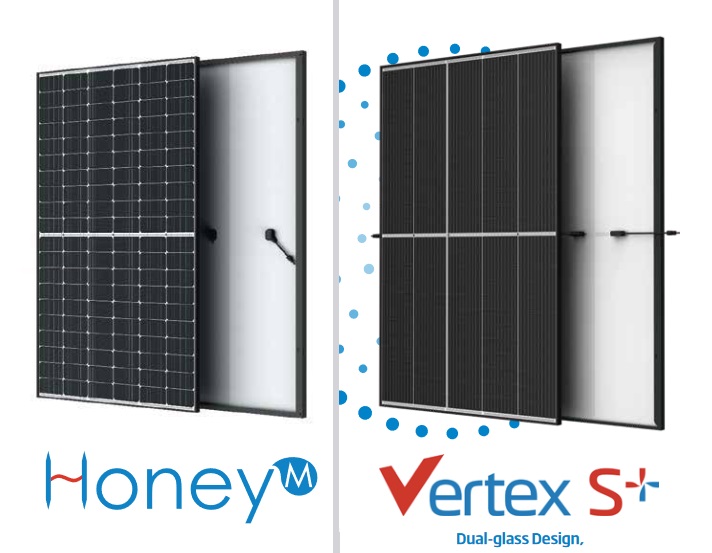
Image: Midjourney “bearded man drowning in a sea of warranty documents”
Trina Solar: A Company That Acts Better Than Its Warranties Require
Trina Solar is a giant Chinese company and, in 2022 was the world’s second-largest producer of solar panels. Their products are among the most common electricity-producing rectangles on Australian roofs. Trina Solar have a reputation for providing a good combination of affordability and reliability. Trina also provides good after-sales support for their products. If you have a problem with their panels under warranty, you will likely receive a satisfactory response. But this support is not thanks to the quality of Trina’s warranties.
If you look through their warranty document, as I have, you’ll see it’s quite miserable and only commits Trina to provide what I would call a completely inadequate level of compensation for panels that fail or underperform.
In this article, I will tell you all about Trina Solar panel warranties whether you want me to or not. I will weave a web of warranty details from which you cannot escape. If you don’t believe me, try to stop reading…
See? You couldn’t do it, could you?
But don’t worry. This isn’t going to be a random info dump as untidy as a web butt-spun by a disorientated redback. Sticky threads will link strong supporting strands. It will describe…
- Trina’s warranties — both Product & Performance — for the seven types of solar panels they sell in Australia.
- What’s hidden in the warranty fine print.
- How the wording of the warranties technically allows Trina to provide very little compensation when things go wrong.
- How Trina Solar normally provides better customer support than the minimal amount their warranties require.
But before I do all that, I’ll present some facts and figures to convey how enormous Trina Solar’s panel production was last year.

Because I was told a picture of real spiders would drive arachnophobes away, here are some cute Japanese anime spiders. (Yes, Japan has cute everything.)
Trina Solar Makes A Lot Of Panels
Last year Trina produced around 35 gigawatts (GW) of solar panels. All within China. That’s only an estimate as the figures for the final quarter of 2022 aren’t yet in. But even if it’s adjusted down, it will still be a massive amount. It’s still likely to be over 4 watts for every person on the planet or roughly half a solar cell each.
Trina’s panels tend to be large, so if we assume the average size was 500 watts, that’s 70 million panels. The only company that beat them was Longi Solar, another Chinese manufacturer with an estimated 40GW of production.
To help you appreciate just how large Trina’s 2022 panel production was, here are some mind-blowing facts and figures:
- If you took Trina Solar’s entire panel production for 2022, you would be arrested for one of the most audacious thefts in history.
- If you laid all the panels Trina produced last year end to end; it would be a massive waste of resources.
- If you attempted to stack just one hour of Trina’s solar panel production on top of each other, their inevitable collapse could kill you.
- If you covered the Panama Canal with Trina Solar panels, they would sink.
- If you ate one panel a day, you would die before eating them all. Almost certainly on the first day.
But if you’re the sort of person who prefers more conventional and boring mind-blowing facts — ones that often completely ignore associated problems with the law, engineering, and physics — then I can also tell you:
- Last year Trina Solar’s production averaged around 8,000 panels per hour.
- Laid end to end, their 2022 panel production would wrap around the equator 11 times.
- Laid flat, without gaps, they would cover 60% of Sydney Harbour.
- The roughly 35GW of solar panels they produced will generate more energy annually than NSW’s entire fleet of coal generators did in 2022.
Trina plans to increase its production by roughly 40% to around 50GW of panels this year.
Trina’s Panels & Warranties
Trina provides their panels with both Product and Performance warranties.
- Product Warranties: These cover defects in panels due to problems with their manufacture. The defects may be obvious from when they’re first installed or become apparent with use.
- Performance Warranties: These promise the panels will maintain a minimum level of performance over time. For most solar panels, it’s 25 years, but for their dual glass panels, Trina provides a 30 year product warranty.
In addition to these two warranties, you are also protected by Australian Consumer Guarantees. This is a good thing because even the best solar panel warranties I’ve seen provide much less protection than our Consumer Guarantees. Trina’s written warranties aren’t the worst I’ve seen, but they are far from the best.

I’m not a lawyer, so I definitely can’t say, or even imply, that this accurately represents the amount of consumer protection provided.
Trina’s 7 Panels
Trina currently sells seven series of solar panels in Australia. Four of them are standard panels, while three are Dual Glass:
- Standard Panels: These have glass on the front to let sunlight reach the solar cells and a plastic backsheet.
- Dual Glass: These have glass on the front and back. The extra support and stiffness the second sheet provides can reduce deterioration in output over time, so Trina gives their Dual Glass panels a 30 year performance warranty instead of 25 years. Bifacial panels are Dual Glass panels that use light from the front and back. These aren’t normally used for rooftop solar because, when installed flush with a roof, there’s no light behind them to take advantage of.

The Honey M has a plastic backsheet for its rear surface, while the Vertex S+ dual glass panel has a glass sheet at the front and rear. Despite this difference, their rears look much the same.
Two of the four standard panels have 12 year Product Warranties, while the other two have 15 years, and all have identical Performance Warranties. I’ve listed them below in order of Product Warranty length. The percentage after the Performance Warranty is the minimum amount of original performance the warranty promises in its final year:
- Tallmax M & Vertex panels: 12 year Product Warranty & 25 year Performance Warranty (84.8%)
- Honey M & Vertex S panels: 15 year Product Warranty & 25 year Performance Warranty (84.8%)
The warranties for their three Dual Glass panels are:
- Vertex Bifacial: 12 year Product Warranty & 30 year Performance warranty (85%)
- Vertex N: 12 year Product Warranty & 30 year Performance Warranty (87.4%)
- Vertex S+: 25 year Product Warranty & 30 year Performance Warranty (87.4%)
As you can see, the Tallmax M and ordinary Vertex panels have the least warranty protection while the Dual Glass Vertex S+ has the most, with a 25 year product warranty. These are also, respectively, the cheapest and most expensive Trina Solar panels.
Performance Warranties & Permitted Degradation
Trina’s Performance Warranties allow their solar panels to degrade in performance by a specific maximum amount per year. But they also allow for a greater reduction in output in their first year. The first-year decline and subsequent annual degradation — or “attenuation” as Trina calls it — is the same for all four standard panels:
- Honey M, Tallmax M, Vertex, & Vertex S: 2% first-year degradation followed by 0.55% annual degradation (84.8%)
The Dual Glass panels vary in permitted degradation:
- Vertex Bifacial: 2% first-year degradation followed by 0.45% annual degradation (85%)
- Vertex N & Vertex S+: 1% first-year degradation followed by 0.4% annual degradation (87.4%)
Big Problems In Little Print
Trina’s warranties are easy enough to find on their site. You go to the bottom of the page and click on “downloads“. After clicking on the relevant type of panel it will let you download a range of documents, including warranties.
Unfortunately, there are conditions in the small print of these warranties that make them far less valuable than a reasonable person will likely conclude from the warranty periods and allowed degradation figures I’ve given above. Trina warranties are not unusual in this respect.
I’ve never seen a solar panel warranty that didn’t contain conditions with the ability to greatly reduce its value to panel purchasers. Fortunately, the results of this aren’t nearly as bad as they could be, as Trina has displayed a willingness to go beyond the minimal amount of support the words of their piss-weak warranties require.
Installation Requirements
For their warranties to apply, Trina says panels must be installed and maintained according to the requirements of the user manual. This is stated in the warranty document and the first page of the user manual has this passage:
“Failure of the customers to follow the requirements outlined in the User Manual during the handling (including without limitation to the packing/unpacking, loading/unloading, transportation, storage, installation, use, operation or maintenance, etc.) of the products will result in the invalidity of the product’s limited warranty.”
This kind of requirement is normal for solar panels, but some of the things in the user manual are ridiculous. For example, it says…
“It is recommended to perform a preventative inspection every six months…”
This requirement is absolutely bonkers. For a well-installed system, an inspection every 5 years should suffice. It is unreasonable to expect a homeowner to pay someone every six months to go on their roof to inspect their solar system. It would be a horrible waste of time and money. The manual says this is a recommendation rather than a requirement, but because I’m not a lawyer, I can’t say whether or not Trina could claim their warranty doesn’t apply if you don’t follow their recommendation to have your solar panels inspected twice a year.
The user manual also states:
“The modules shall be installed in shadow-free areas throughout the year.”
This would mean any shading on the panels, even if it’s only a little in the middle of winter, has the potential to render the warranties void.
Another recommendation is:
“Trina Solar recommends that the mounting tilt angle should not be less than 10°.”
Most roofs have a tilt of more than 10° degrees, but this is another potential problem for some installations.
Keep Your Purchase Details
Trina Solar’s warranty document says the warranties don’t apply if you can’t provide proof of purchase.
Utterly Inadequate Warranty Remedies
If one of your solar panels either clearly underperforms or fails altogether while under warranty, you might expect Trina to provide a repair, replacement, or refund. And this is normally what they do.
But their warranty document says the actual amount of support they’re required to provide is at their discretion and can range from meagre to useless. It says it’s up to Trina which of the following remedies they’ll provide:
- A repair.
- A replacement.
- A refund based on the output of the panels and the minimum performance allowed by the warranty. This is calculated by taking the difference between the two figures and multiplying it by the market value of an equivalent panel at the time the refund is provided. So if you had a panel that degraded to 80% and its performance warranty said it should have at least 90% of its original capacity, they could refund you 10% of the panel’s market value. That might be around $15. This amount will decrease as solar panels come down in price.
- A refund based on the time left in the warranty. For example, if 30% of the warranty period remains, they can refund 30% of the market price of an equivalent panel at that time. So ,if the market price of a panel is $100 at that point, they can provide a refund of $30.
- Provide additional panels to make up for the loss of output. If you have 10 panels and they provide an average of 10% less output than the minimum allowed by their performance warranty, then Trina could provide one new solar panel to make up the difference. Because it’s often not possible to tack an extra solar panel onto a system, and basically never practical to do so, this is almost — but not quite — the complete opposite of being a solution.
Cost Of Labour Not Covered
If Trina decides to provide replacement panels, the warranty document says Trina is only responsible for their delivery, not labour or other installation costs.
Trina’s Support Goes Beyond Their Warranty
If you’ve read this far and think Trina Solar panel warranties sound terrible, I have successfully conveyed the truth to you. But I have good news.
In Australia, Trina generally goes beyond providing the minimum amount of support their warranties require. They could be doing this out of the kindness of their corporate hearts or because they want to protect their reputation and live up to most of their obligations under Australian Consumer Guarantees.
One example of how Trina lives up to their obligations under consumer law occurred around 10 years ago when many Trina Solar panels suffered from water ingress due to failing backsheets. But, as far as I know, these panels were replaced under warranty. Some companies, when faced with similar problems, fled the country and left customers in the lurch.
The fact that Trina didn’t do a runner speaks well of their honesty and commitment to the Australian market. Unfortunately, their commitment doesn’t extend as far as providing a better warranty document to Australians. But it appears you can get them to follow the gist of Australian Consumer Law without twisting their arms too much.
Because they support their products, Trina is among the 16 solar panel manufacturers we recommend using in our Solar 101 Guide. But as we base our recommendations on what we hear from installers and members of the public, please let us know if you’ve had a bad experience making a warranty claim with Trina — or a particularly good one.
In the 2023 SolarQuotes Installers’ Choice Awards, Trina took out bronze in the best solar panels category, gold in the best value panels category, and bronze for best after-sales support.
Related: Pick up some handy tips on choosing solar panels.


 RSS - Posts
RSS - Posts



The cost to inspect the Trina panels on my roof – to identify the failed panels, as no labour is covered, was significant enough to not bother trying to claim – and purchase a new system (with non-trina panels this time)
As one of Trina’s primary EPC/installers in APAC for commercial + industrial and with over 200MW over 12 years I can testify to the Quality and the warranty support Trina has provided.
The T&Cs are superceded by the Australian Consumer Law and therefore the local office, the importer, the retailer are all on the hook…
but more than that; I have found the attitude of the Australian/local Trina office has been positive and helpful. When we have incurred costs, over and above the standard terms, we have appealed and Trina has paid up.
Installers also need to take responsibility. So many warranty claims are actually through installer handling issues.
This points to two benefits of buyung solar from someone like Smart Commercial Solar; we are big, proactive, And a meaningful solar provider and therefore manufacturers will want to make sure we are happy, and we are happy when our clients are happy.
Also, if you are going to beat Trina up, why not take a look at the other brands and their importers/middle men too.
Hi Huon,
As this post is a year old I thought you’d like to see the newest one we have out on Trina. Glad to get some different perspectives on it if you have any.
Cheers for the feedback
With respect to the comment
The user manual also states: “The modules shall be installed in shadow-free areas throughout the year.” This would mean any shading on the panels, even if it’s only a little in the middle of winter, has the potential to render the warranties void. Another recommendation is: “Trina Solar recommends that the mounting tilt angle should not be less than 10°.”Most roofs have a tilt of more than 10° degrees, but this is another potential problem for some installations.
if Supplier/Installer was aware of this requirement of the manufacture then this is completely a misleading and deceptive conduct by Supplier/Installer as they have seen the property and gave quotes and then proceeded to install the panels knowing that the property roof is not adequate to the manufacture’s warranties.
Home owners should seek their Solicitors advice and also if this is a current situation then I believe your Board should lodge a general complaint to the ACCC about the product warranties first provided by the Supplier/Installer and Manufactures and once many thousands of customers have installed the product the Supplier/Installer and Manufactures decides to disobey the Warranties and External Warranties. (This act falls under deceptive and misleading representations. (refer https://www.accc.gov.au/media-release/lg-to-pay-160000-for-misleading-representations-to-two-consumers)
Ronald, I think these warranty issues is a big problem that we should collectively raise with the consumer council to ensure that the companies live up to a proper warranty. My system has been in service since December 2010. The installer went bankrupt within about three years so you sit with the original manufacturers to look after you. My inverter failed and I replaced it withan SMA as I did not want to get the same rubbish again. So I did not launch a warranty claim. However it looks now as if some of the solar panels did get water in and also looking at the soldering joints inside the panels it does not look good. I cannot find out who made these panels as their label have become illegible after 13 years. Due to that fact that we are on the Victoria Premium feed in Tarif I have most probably got my money back by now but the issue for me is that the suppliers of the solar panels should be hold to account for their 25 year warranty that they provide.
I would suggest that all customers should make sure the know who are the suppliers of their panels and if there is a local agent for them. I think it will be very difficult to try and get any response from a company in China.
If we do not stand up and raise this issue it means that the shoddy manufacturers with their useless warranty clause get the business whilst the real good suppliers loose business as the no good ones offer panels at lower prices.
Chev Viviers
trying to find a simplfied version for my clients is impossible please trina we dont need a document for every model youve ever produced just a simplified limited warranty doc would be great!
My trina panels have been turned off about 6 months ago. Installed them about 10 yrs ago. So have cost me approx $800 per year. Started failing about 2 years ago. 3 panels replaced under warranty but never installed. Now the majority have failed so has been turned off by the installer. They won’t warrant the replacement of them now so looking at new system. Not worth the money
30 Oct 2024 update from Trina.
I rang Trina today: Transport included, labour reinbursement as below.
The below is from an email Trina sent me.
Would be great if article could be updated.
Dear customer,
Thank you for contacting Trina Solar!
Below you’ll find a detailed, step-by-step guide on how to submit an invoice claim for warranty reimbursement:
1. You can submit each invoice online through our customer service portal (http://customerservice.trinasolar.com ) under a new Module claim. (Type “000” in SN page and upload your invoice in the attachment page).
2. Our reimbursement rate for replacing systems up to 7kw is as follows:
AUD 200 for the first panel
AUD 50 for each panel after
+ GST
3. Please title the invoice as:
Trina Solar (Australia) Pty Ltd
2 Banfield Rd, Macquarie Park,
NSW 2113 Australia
4. Include all RMA reference numbers of the original module claims
5. Pls attach the signed Installation Completion Certificate as proving doc; Attachment: Installation Completion Certificate;
Attachment: Trina Solar Supplier Bank Information Confirmation Letter;
Pls kindly complete this letter and upload along with your invoice, as it is a MUST for international bank transaction proceeded from China.
Thanks for your time and support!